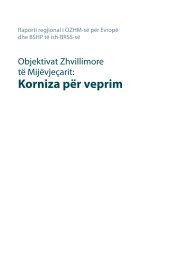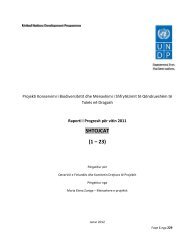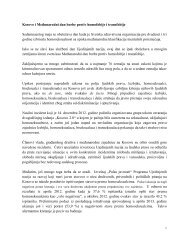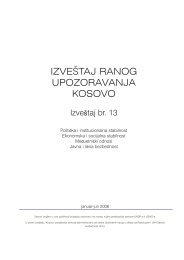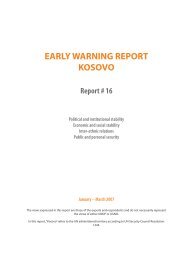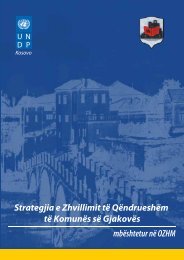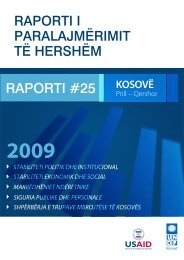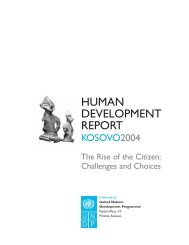Kosovo Human Development Report 2010 - UNDP Kosovo - United ...
Kosovo Human Development Report 2010 - UNDP Kosovo - United ...
Kosovo Human Development Report 2010 - UNDP Kosovo - United ...
You also want an ePaper? Increase the reach of your titles
YUMPU automatically turns print PDFs into web optimized ePapers that Google loves.
27 Ibd.<br />
28 MEST 2009/ <strong>2010</strong>.<br />
29 SOK 2002-2008.<br />
30 MEST 2009/ <strong>2010</strong> and SOK 2002-2008.<br />
31 IMF Country <strong>Report</strong> No. 10/245, July <strong>2010</strong>.<br />
Chapter 2<br />
32 See World Bank, <strong>Kosovo</strong> Economic Memorandum, Poverty Reduction and Economic Management Unit, European<br />
and Central Asia Region, <strong>Report</strong> No: 28023 KOS, 2004.<br />
33 Domestic credit increased from 892 million Euros as of December 2007 to 1,183 million Euros in December 2008<br />
amounting to a yearly increase of 32.6% (Central Bank of <strong>Kosovo</strong>, Monthly Bulletin, May 2009).<br />
34 All growth rates except for the CPI are given in constant prices.<br />
35 Statistical Office of <strong>Kosovo</strong>, Labour Force Survey 2008, 2009.<br />
36 Disproportionally affecting youth, women and long term unemployed.<br />
37 See <strong>UNDP</strong>, “Early Warning <strong>Report</strong>” Fast Facts Nr. 25, 26, 27, 2009.<br />
38 Statistical Office of <strong>Kosovo</strong>, Labour Force Survey 2008, 2009.<br />
39 Living below the poverty line of EUR 1.42 per adult equivalent per day in 2002 prices.<br />
40 Living below the extreme (food) poverty line of EUR 0.93 per day in 2002 prices.<br />
41 The two-third of all the poor lived in rural areas based on the World Bank Poverty Assessment report (World Bank,<br />
2007).<br />
42 <strong>Kosovo</strong> Mosaic Survey was 2009 conducted with 6,400 households from 33 municipalities. The survey collected<br />
primary data through face-to-face interviews using a custom-designed research tool. Each of <strong>Kosovo</strong>’s thirty-three<br />
municipalities was assigned a proportional number of respondents based on population figures and the sample<br />
was split equally between urban and rural areas, to reflect the differing nature of <strong>Kosovo</strong>’s human complexion and<br />
to ensure that the sample is representative of the whole of <strong>Kosovo</strong>.<br />
43 <strong>Kosovo</strong> Remittances Study, <strong>UNDP</strong> <strong>Kosovo</strong>, <strong>2010</strong>.<br />
44 When the World Bank calculates that in the absence of social assistance, poverty is higher by about 2 percentage<br />
points; whereas in the absence of pensions poverty is higher by about 4 percentage points (See World Bank 2007).<br />
45 The social protection system in <strong>Kosovo</strong> comprises social assistance benefits, a basic pension system and disability<br />
pensions, complemented by special schemes for war invalids. The World Bank calculates that in the absence of<br />
the social assistance, poverty would be higher by about 2 percentage points; whereas in the absence of pensions<br />
poverty would be higher by about 4 percentage points (See World Bank 2007).<br />
46 While basic pension system is paid to each individual above 65 year age in amount of EUR 40, social assistance<br />
benefits are paid to households in average amount of EUR 60 (See White Paper on Social Policies, 2009).<br />
47 Specifically, over 75 percent of the poor are not reached by the social assistance program. The social protection<br />
programmes provided income support to some 8 percent of the population that is, about 2 percent by social assistance<br />
and 6 percent by pensions. The poverty-targeted social assistance benefit reaches only 22 percent of very<br />
poor households and 16 percent of poor households, while the basic pension reaches 94 percent of those 65 (See<br />
World Bank 2007).<br />
48 According to the World Bank Poverty Assessment about 1 in 5 Kosovans report having at least one household<br />
member who is a migrant abroad, just as many reported having received remittances from abroad. By comparison<br />
only 13 percent of the population receives social assistance benefits (World Bank 2007).<br />
49 The data from the table 2.5 showed that 30.2 percent of those households excluded from basic goods and services<br />
have one employed member. Similarly, 28.7 percent of those unable to meet their critical needs are poor despite<br />
access to both land and the labour market.<br />
50 See Khan, A. (2005).<br />
51 The World Bank Poverty Assessment in 2007 reports a growing inequality for <strong>Kosovo</strong>, especially in rural areas. The<br />
most commonly reported measure of inequality (the Gini index) increased from 27 percent to 30 percent in 2005.<br />
52 Currently, the private sector in <strong>Kosovo</strong> is dominated by micro-enterprises and continues to be heavily oriented<br />
towards small-scale trading and low-value-added services. According to Business Registration (ARBK) statistics,<br />
there are around 90,000 registered businesses in <strong>Kosovo</strong>, of which 98% are micro-enterprises. Most firms are organized<br />
as sole proprietorships (91%) and partnerships (3.3%), employing less than five workers. In terms of sectoral<br />
distribution, of the 90,000 firms registered, about 56% are engaged in trade, hotels and restaurants, 9.4% are in<br />
manufacturing, and 1.8% are in agriculture (SME Agency: Annual <strong>Report</strong> in 2009).<br />
53 Doing Business <strong>2010</strong>, Reforming Through Difficult Times, World Bank & IFC, a Co-publication of Pulgrave Macmillan,<br />
IFC and the World Bank, 2009.<br />
54 See World Bank 2007.<br />
55 See SOK, Labour Force Surveys 2004- 2008.<br />
56 An Overview of Business Owned by women in 2006, SHE-ERA, Women Entrepreneurs in <strong>Kosovo</strong>: Research Paper,<br />
2006.<br />
57 See SHE-ERA (2006).<br />
58 See World Bank (<strong>2010</strong>).<br />
59 In 2008, only 4 percent of business credits were channelled into the agriculture sector: see Central Bank of <strong>Kosovo</strong>,<br />
Monthly Statistics Bulletin, December 2008.<br />
60 World Bank <strong>Report</strong> on Enhancing Job Opportunities in Eastern Europe and CIS, 2005.<br />
61 Smallholder farming is defined as operating a farm of 2 hectares and less.<br />
62 Extension services are non-formal educational program implemented and designed to help people use researchbased<br />
knowledge to improve their agricultural production or life. The services are usually provided by the state’s<br />
designated institutions. In most states the educational offerings are in the areas of agriculture and food, home<br />
and family, the environment, community economic development and youth.<br />
63 Exposure to uninsured risks – the result of natural disaster or weather change and price volatility- has high efficiency<br />
and welfare cost for rural households and little progress has been made in reducing uninsured risks in<br />
smallholder agriculture.<br />
64 Child Poverty in <strong>Kosovo</strong> - Policy Options Paper, UNICEF <strong>2010</strong>.<br />
108 | KOSOVO HUMAN DEVELOPMENT REPORT <strong>2010</strong>



